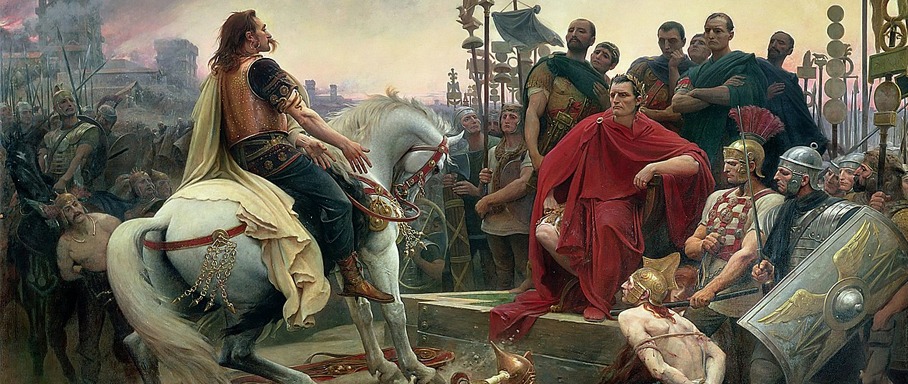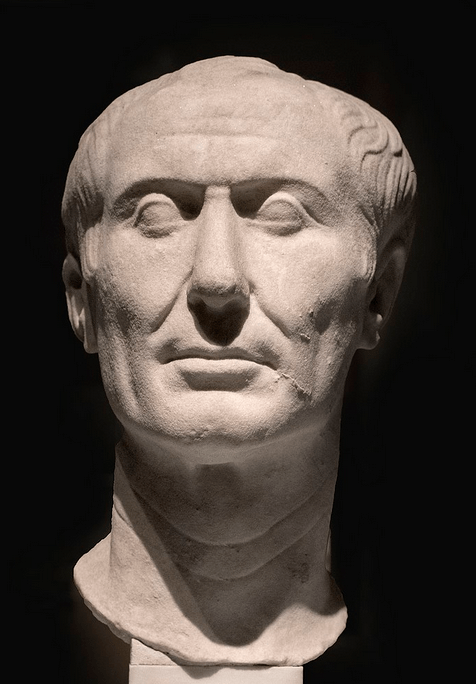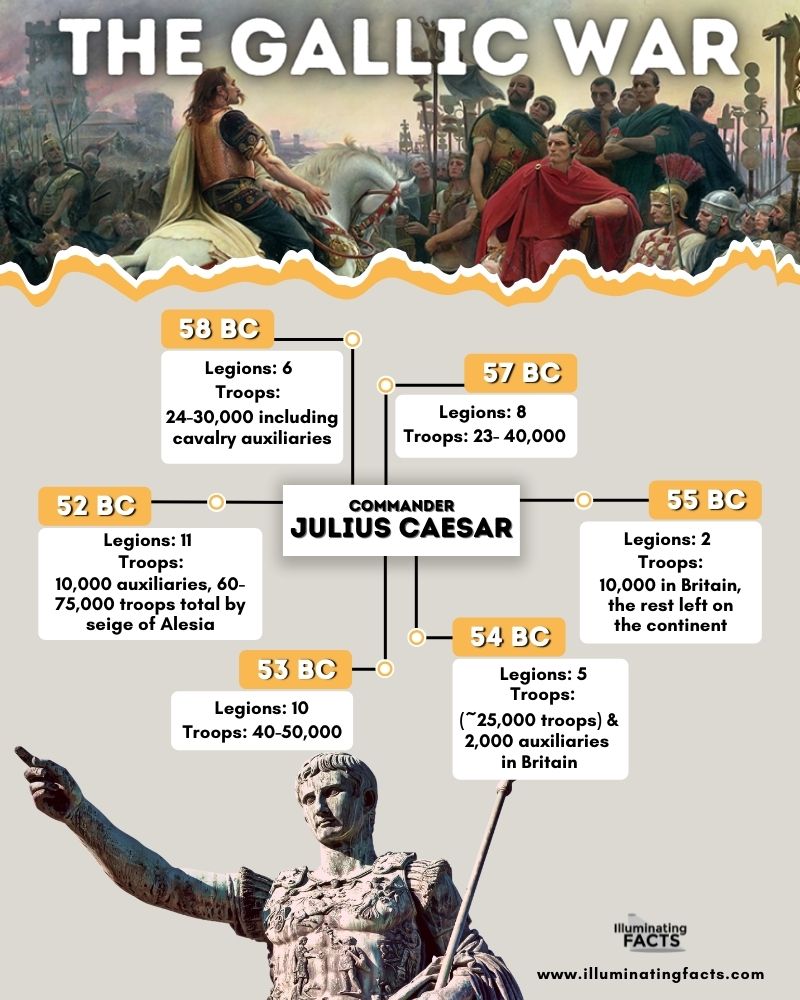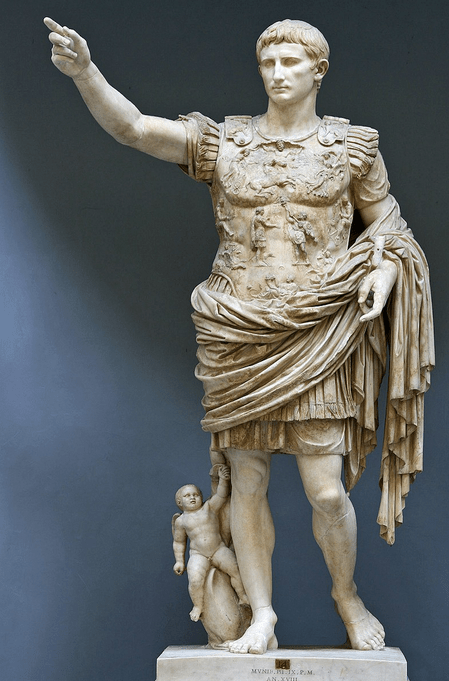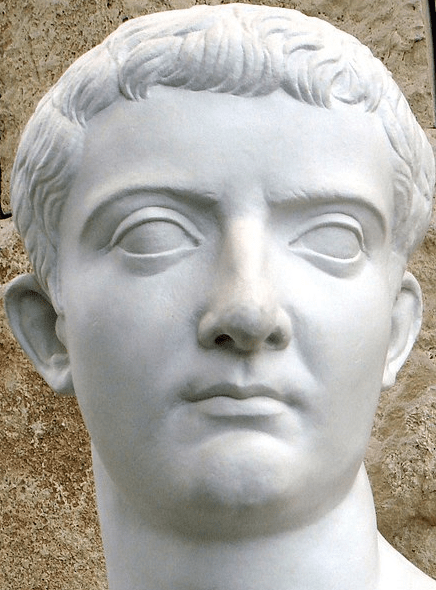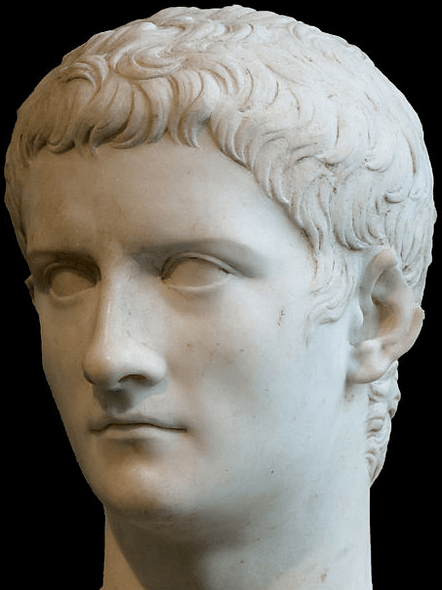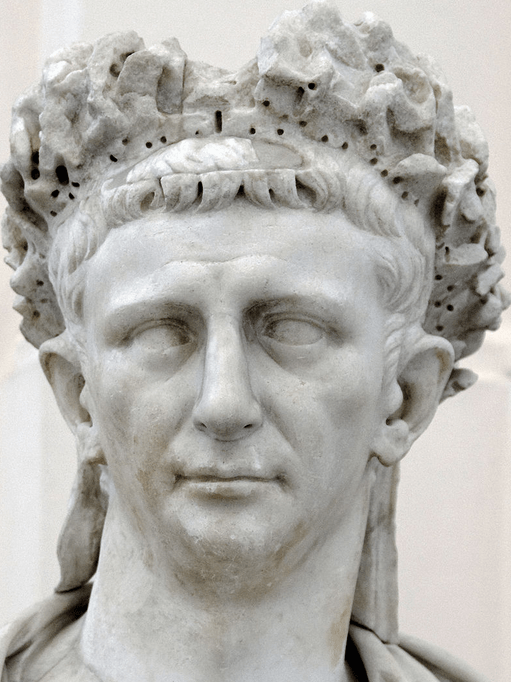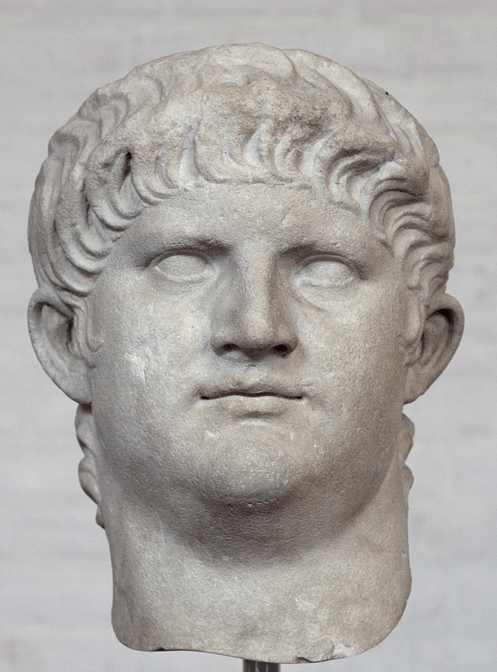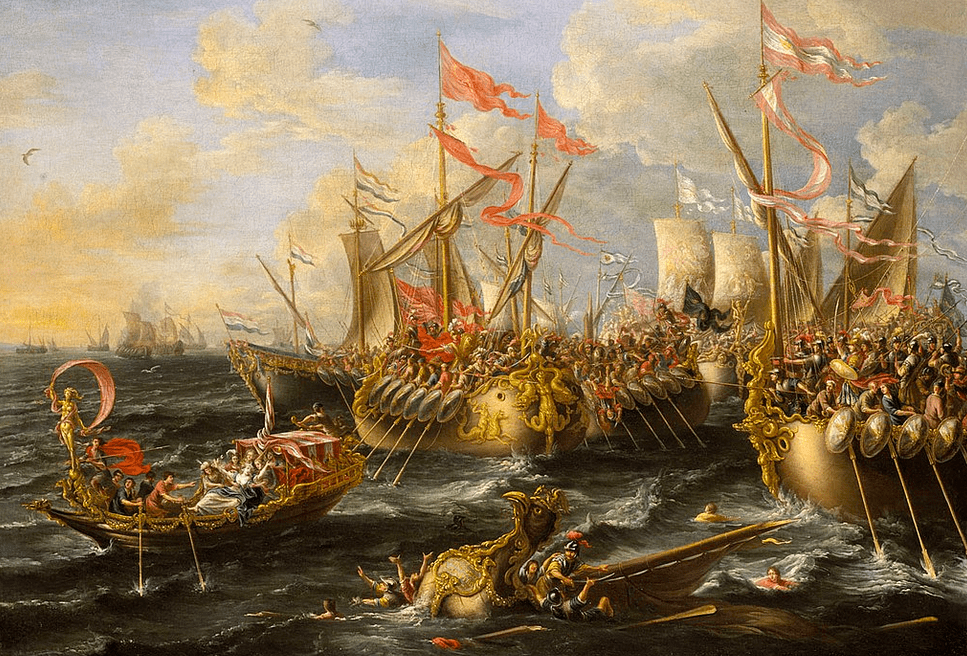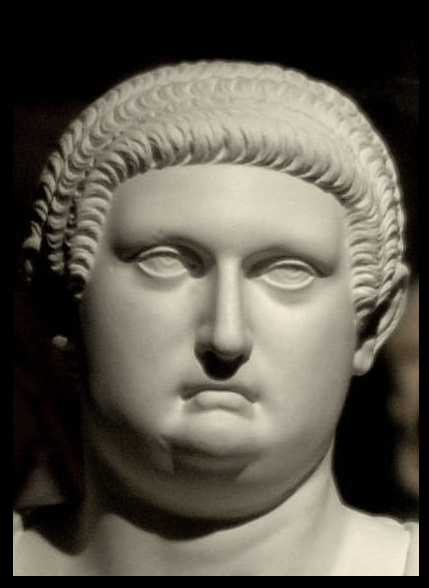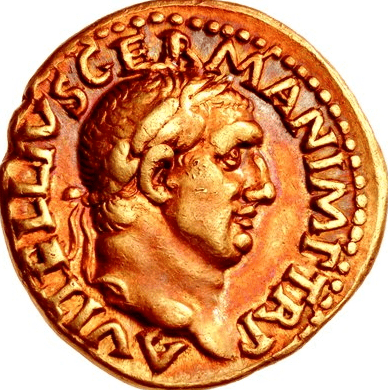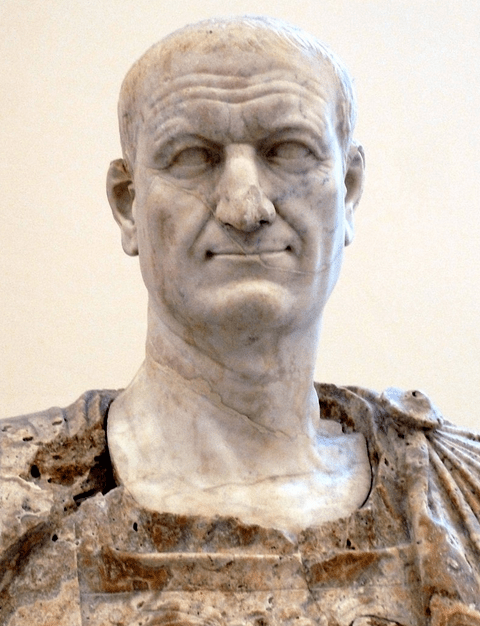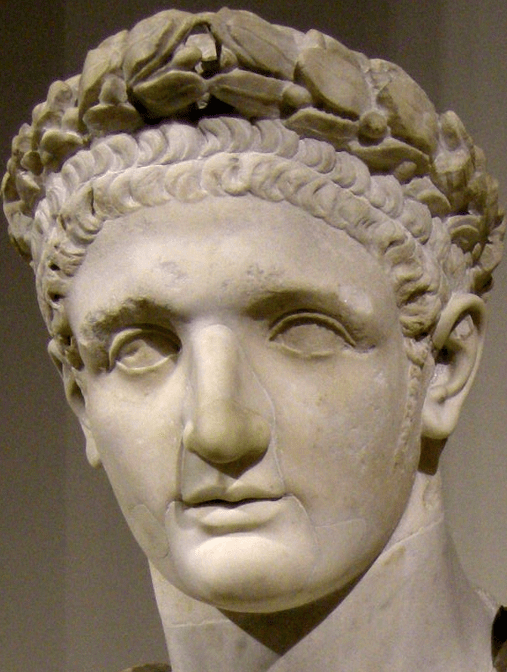Table of Contents
Caesar is a title with imperial connotations. It is derived from the Roman dictator Julius Caesar’s cognomen.
Following the fall of the Julio-Claudians, the title of Caesar, the ancestral name, became synonymous with the heir to the throne (who could trace some semblance of familial connection to Caesar, the dictator).
Vespasian created this to link his sons Titus and Domitian’s designation as heirs to the original reigning dynasty.
In the early time, the emperor’s title (Imperator) was “Augustus,” which meant “exalted one,” as well as Princeps (from Princeps inter pares Senatus for first among equals in the Senate).
Augustus was given the name Gaius Julius Caesar, after the original dictator, when he was adopted. As each successive emperor was adopted (for example, Tiberius by Augustus), he was given Caesar to signify his adoptive heritage. [1]
The 12 Caesars
There were 12 Roman Caesars, each vividly portraying the Roman Empire at its pinnacle of power and influence.
One was a military prodigy, another murdered his mother and fiddled while Rome burnt, and another earned the nickname “sphincter artist.” Six of them were assassinated, two committed suicide and the other five were raised to godhood. Julius Caesar, Augustus, Tiberius, Caligula, Claudius, Nero, Galba, Otho, Vitellius, Vespasian, Titus, and Domitian are known as the “twelve Caesars.” From 49 BC to AD 96, they ruled Rome, transforming it from a republic to an empire whose regal autocracy model would last for almost a thousand years in the West.
Gaius Julius Caesar
Source: Museum of antiquities, Public domain, via Wikimedia Commons
Born: 12 July 100 BC
Died: 15 March 44 BC (aged 55)
In the Roman Empire, Gaius Julius Caesar was a general and statesman. Before conquering Pompey in a civil war and controlling the Roman Republic as a dictator from 49 BC to 44 BC, Caesar led Roman soldiers in the Gallic Wars. He played a pivotal role in the events that led to the Roman Republic’s demise and the emergence of the Roman Empire.
The First Triumvirate was created in 60 BC by Caesar, Crassus, and Pompey, and it controlled Roman politics for several years. Their attempts to gain power as Populares met opposition from the Optimates in the Roman Senate, including Cato the Younger, who had Cicero’s support. Through a series of military triumphs in the Gallic Wars, completed by 51 BC and considerably expanded Roman territory, Caesar became one of the most prominent politicians in the Roman Republic.
He captured Britain and built a bridge across the Rhine River during this time. Pompey’s standing was endangered by these accomplishments and the support of his veteran army, which had realigned itself with the Senate after Crassus’ death in 53 BC. With the Gallic Wars over, the Senate ordered Caesar to relinquish command of his army and return to Rome. By crossing the Rubicon and advancing towards Rome with an army in 49 BC, Caesar publicly rejected the Senate’s authority. [2] This sparked Caesar’s civil war, which he eventually won, giving him near-unchallenged authority and influence in 45 BC.
The Eight Gallic War Battles [4]

Source: Lionel Royer, Public domain, via Wikimedia Commons
Julius Caesar, a Roman general, the Gallic Wars were fought between 58 and 50 BC against the Gaulish people (present-day France, Belgium, and parts of Germany). Against an aggressive Roman campaign, Gallic, Germanic, and Brittonic tribes struggled to defend their homelands.
1. Battle of Bibracte
In 58 B.C., the battle took place. The Romans won under Julius Caesar, while the Helvetii lost under Orgetorix. In the Gallic Wars, this was the second important combat. Although Caesar claimed that 130,000 Helvetii and allies survived the battle, only 11,000 were confirmed to have returned home.
2. Battle of Vosges
In 58 B.C., the Battle of Vosges took place. The Romans won under Julius Caesar, while the Germans lost under Ariovistus. This conflict, also known as the Engagement of Trippstadt, was the third major battle of the Gallic Wars, in which Germanic tribes crossed the Rhine in search of a new home in Gaul.
3. Battle of the Sabis River
In 57 B.C., the Sabis battle took place. The Romans were victorious under Julius Caesar, while the Nervii were defeated. The Engagement of the Sambre was another name for this battle. It occurred between the Roman Republic’s troops and is now known as the present river Selle in northern France.
4. Battle of Morbihan Gulf
In 56 B.C., the Battle of Morbihan Gulf took place. The naval fleet of the Romans, led by D., won the battle. The Veneti took Junius Brutus and killed him. Caesar considered the Veneti rebels to be traitors, and they were severely punished. This was the first naval fight to be documented in history.
5. The Gallic Wars
In the year 54 B.C., The Roman troops of Cotta and Sabinus were wiped out by the Eburones under Ambiorix. The Romans suffered their first big setback in Gaul with this disaster. They then besieged the forces under the leadership of legate Quintus Cicero. When Caesar learned of the situation, he came to the rescue and defeated the Eburones. Roman legate, Labienus’ troops, beat the Treveri forces led by Indutiomarus.
The Gallic Wars (also called the Gallic Revolts) were a series of military engagements resulting in a decisive Roman triumph in Gaul, Germania, and Britannia.
6. Battle at Gergovia
In 52 B.C., the Battle of Gergovia took place. The Gauls under Vercingetorix prevailed in south-central Gaul, and the Romans under Julius Caesar lost. During the whole Gallic War, this was Caesar’s army’s sole significant setback.
7. Battle at Lutetia Parisiorum
In 52 B.C., the Battle of Lutetia Parisiorum took place. The Romans won under Labienus, while the Gauls lost under Camulogenus. Lutetia was renamed Paris in 360 AD, based on the tribe name “Parisii” from the Gallic Wars.
8. Battle of Alesia
The Romans under Julius Caesar won the Battle of Alesia, also known as the Siege of Alesia, in 52 B.C., while the Gauls under Vercingetorix lost. This was the last major fight between the Gauls and the Romans, and it is regarded as Caesar’s greatest military victory.
The Gallic War
Caesar’s Civil War
Caesar’s Civil War in 49–45 BC was one of the Roman Republic’s final politico-military battles before being reorganized into the Roman Empire. It all started with a series of political and military clashes pitting Julius Caesar (100–44 BC), his political supporters (commonly known as Populares), and his legions against the Optimates (or Boni), the Roman Senate’s [5] politically conservative and socially traditionalist faction, who were backed by Pompey (106–48 BC) and his legions. [6]
The Four Major Events in Caesar’s Civil War[7]
10th of January, 49 BC
With his army, Roman general Julius Caesar crossed the Rubicon River into Italian territory, launching a civil war against the Roman Senate’s politically conservative side, eventually leading to the dissolution of the Roman Republic and the Roman Empire.
9th of August, 48 BC
Julius Caesar defeated a Senatorial army led by Gnaeus Pompeius in Caesar’s Civil War at Pharsalus in central Greece.
28th of September, 47 BC
During his exile in Egypt, Pompey, a military and political leader of the Roman Republic, is stabbed to death by his betrayer.
17th of March, 45 BC
At the Conflict of Munda, the final battle of Julius Caesar’s civil war, he overcomes a conservative republican army and returns to Rome to reign as dictator.
Julius Caesar’s Battle Record
Murder of Caesar
In 44 BC, on March 15, senators assassinated Julius Caesar, the Roman dictator, at a Senate session at the Curia of Pompey of the Theatre of Pompey in Rome. The senators stabbed Caesar a total of 23 times. The senators justified their actions as an act of tyrannicide, claiming that Caesar’s unparalleled consolidation of power during his dictatorship was destroying the Roman Republic.
The conspiracy involved at least 60 senators, led by Marcus Junius Brutus and Gaius Cassius Longinus. Despite Caesar’s murder, the conspirators could not restore the Republic’s institutions. The assassination’s consequences led to the Liberators’ civil war and, eventually, the Roman Empire’s Principate period.
Julio-Claudian Dynasty
Augustus, Tiberius, Claudius, Caligula, and Nero were the first five Roman emperors of the Julio-Claudian dynasty.[8]
From the time the Roman Empire was founded (under Augustus in 27 BC) until the last line, emperor Nero committed suicide. This line of emperors governed the Roman Empire (in 68 AD).
The name Julio-Claudian derives from the two families that made up the imperial dynasty: the Julii Caesares and the Claudii Nerones.
Five Roman Emperors
Source: Vatican Museums, Public domain, via Wikimedia Commons
1. Augustus
Rule: 16 January 27 BC – 19 August AD 14
As Caesar’s adopted son and successor, Augustus (Imperator Caesar Divi Filius Augustus) shed his natural father’s surname and called himself “Gaius Julius Caesar” after his adoptive father. It was also usual for the adopted boy to add an extra name to his new name to honor his birth family. Augustus’ adopted name would have been “Gaius Julius Caesar Octavianus” because of this. There is no proof, however, that he ever went by the name Octavianus.
Augustus’ family became a de facto royal house with his ascension as the first emperor of the Roman Empire in the late 27 BC, which historians call the “Julio-Claudian dynasty.” The Julio-Claudians adopted as a means of dynastic succession for various reasons, following in the footsteps of Julius Caesar and Augustus. The next four emperors were closely linked through a combination of family relations, marriage, and adoption.
Ten Facts About Augustus
- He was Caesar’s adopted son and grand nephew.
- Caesar’s assassins were defeated by him.
- The last war of the Roman Republic was precipitated by an Augustan family rivalry.
- He instituted plenty of political and social changes.
- The Roman Empire grew by a factor of two during his reign.
- August is the month that bears his name.
- He built the Roman Empire, which lasted approximately 1500 years in various forms.
- Augustus Caesar married three times throughout his life.
- Augustus Caesar was a ruthless man.
- Augustus Caesar sent his daughter into exile.
Source: Giovanni Dall’Orto, Attribution, via Wikimedia Commons
2. Tiberius [9]
Rule: 17 September 14 – 16 March 37
Augustus died on August 19, 14 AD. Tiberius had already been named Princeps in all but name, and Augustus’ testament affirmed his position as successor.
Tiberius’ initial years were mostly good, notwithstanding his complicated relationship with the Senate. He followed Augustus’ succession plans and chose Germanicus, his adoptive son and nephew, over Drusus, his natural son, as did the Roman people.
Germanicus was given proconsular power and resumed command in Germania at Tiberius’ request, where he crushed the mutiny after Augustus’ death and commanded the army on campaigns against Germanic tribes in 14-16 AD. In 19 AD, Germanicus died in Syria, accusing the governor of Syria, Cn Calpurnius Piso, of murdering Tiberius’ instructions. Tiberius began raising his son Drusus as heir after Germanicus died.
Tiberius had delegated much of the day-to-day management of the Roman Empire to L. Aelius Sejanus by this time. His Praetorian Prefect, Aelius Sejanus. Sejanus instilled fear in Rome by commanding a network of informers and spies whose reward for accusing others of treason was a part of the accused’s property upon their guilt and execution.
Treason trials were common, and the Roman nobility was no longer safe. The trials heightened Tiberius’ paranoia, making him rely more on Sejanus and letting him eliminate possible competitors.
Tiberius turned down Sejanus’ request to marry Livilla, Germanicus’ sister and the widow of Drusus the Younger, who had died in 25 AD. On the other hand, Sejanus was betrothed to Julia Livia, daughter of Livilla and Drusus the Younger, in 30 A.D. He was consul with Tiberius in 31 A.D.
10 Facts About Tiberius
- He married his very own daughter, Julia the Elder.
- His mother was controlling.
- Tiberius was obliged to divorce his first wife to marry someone else.
- Tiberius was a founding member of the Julio-Claudian Dynasty.
- Tiberius has been in the military for a long time.
- The Emperor had no faith in anyone.
- His mother gave birth to an infamous bloodline.
- During Tiberius’ reign, Jesus Christ was crucified.
- In the year 26 A.D., Tiberius parted Rome for good.
- When he died, the Roman Empire was enormously wealthy.
Source: Metropolitan Museum of Art, Public domain, via Wikimedia Commons
3. Caligula
Rule: 16 March 37 – 24 January 41
Caligula ordered Tiberius Gemellus, Tiberius’ co-heir, to be executed within his first year in power after Tiberius died. With the support of N. Caligula, he established himself as the only Emperor, though he subsequently assassinated Macro. Caligula branded his brother-in-law, M. Aemilius Lepidus, after Gemellus’ death.
As his heir, Aemilius Lepidus, the spouse of his sister Julia Drusilla. Following Drusilla’s death, however, Lepidus was suspected of having affairs with Caligula’s other sisters, Agrippina the Younger and Julia Livilla, and was put to death. Drusilla’s first husband, L.Cassius Longinus, had previously been his. Cassius Longinus was assassinated.
Caligula was the target of several failed assassination attempts. With the support of the Senate, the angry Praetorian Guard devised the successful plot. The conspirators wanted to bring the Roman Republic back to life.
The Praetorian tribune Cassius Chaerea with his men, stabbed Caligula to death in an underground passage beneath the Palatine on January 24, 41 AD. Caligula’s wife, Caesonia, and their infant daughter, Julia Drusilla, were slain on the same day by him and another tribune, Cornelius Sabinus.
10 Facts About Caligula
- His nickname was Caligula.
- Agrippa The Elder, his mother, was a force of nature.
- Emperor Tiberius and Caligula had a tumultuous relationship.
- His first months as emperor went rather well.
- Vanity projects were funded with large sums of money.
- His greatest legacy was his buildings.
- He transformed a military campaign into a work of performance art.
- He prohibited anyone around him from talking about goats.
- He declared himself an Immortal God, believing he possessed extraordinary abilities.
- Caligula was a horse lover, Incitatus.
Source: Naples National Archaeological Museum, CC BY 2.5, via Wikimedia Commons
4. Claudius
Rule: 24 January 41 – 13 October 54
The Senate endeavored but failed to rebuild the Republic after Caligula’s death. The Praetorian Guards conspired to make Claudius, Caligula’s paternal uncle, Emperor. [10]
Claudius proved to be capable of administering and a great constructor of public works despite his lack of political experience and the people of Rome’s disapproval. After Caligula’s reign of excess, he helped repair the Empire’s finances by expanding the imperial bureaucracy to include freedmen.
He was also a visionary builder who built numerous new roads, aqueducts, and canals. During his tenure, the Empire expanded, including a significant invasion of Britain in 43 AD, which strengthened his bond with the Roman Army.
Suetonius accused Claudius of being a womanizer and being ruled by women and wives. After two failed betrothals, Claudius married four times. His first two wives were divorced for infidelity, and his third wife, Valeria Messalina, was executed for treason. Britannicus and Claudia Octavia, Messalina’s offspring, were born to him.
His final marriage to Agrippina the Younger was politically motivated to strengthen his status as Emperor and give him an heir of legal age, as Britannicus was still too young.
Nero became heir to the throne after Claudius’ son Britannicus was adopted on February 25, 50 AD. Claudius died on October 13, 54 AD, and Nero ascended to the throne. Claudius was suspected of being poisoned by Agrippina.
10 Facts About Claudius
- His own family made fun of his physical disabilities.
- He entered politics at a late stage in his life
- Claudius was a knowledgeable historian.
- He was crowned emperor by the Praetorian Guard.
- Claudius accomplished the annexation of Britain by the Romans.
- He was a huge fan of ancient Greek and Roman sports.
- Claudius had a reputation for being unlucky in love.
- Claudius’ death is still a mystery.
- He was the first Roman Emperor born outside of Italy.
- He praised the guards who had spared his life during the purge.
Source: Glyptothek, Public domain, via Wikimedia Commons
5. Nero
Reign: 13 October 54 – 9 June 68
When Nero became Emperor, he was sixteen years old. Like his uncle Caligula, Nero was a direct descendant of Augustus, making his succession to the throne much quicker and smoother than Tiberius or Claudius’ and poisoned Claudius’ biological successor, Britannicus.
His mother, Agrippina the Younger, tutor Seneca, and Praetorian Prefect Burrus, Nero’s early reign. Nero began to play a more active role as an administrator in 55 AD. Between 55 and 60 AD, he served as consul four times. Nero gradually solidified power by assassinating and banishing his opponents and usurping authority from the Senate. After divorcing her, he is said to have assassinated his mother, Agrippina, and his wife, Claudia Octavia, Claudius’ daughter.
The Great Fire of Rome was illuminated in 64 AD, and Nero organized a public relief effort and large-scale rehabilitation efforts. Following the fire, the provinces were heavily taxed to help pay for it. The Pisonia plot, commanded by C.Calpurnius, followed. Calpurnius Piso was a Roman general. The plot failed, and the conspirators were executed.
Vindex, the governor of Gallia Lugdunensis, revolted in 68 AD with the help of Galba, the governor of Hispania Tarraconensis. Vindex’s uprising failed to achieve its immediate goal, but Nero fled Rome after the civil and military authorities chose Galba as Emperor.
After knowing that he had been tried in his absence and sentenced to death as a public enemy, he committed suicide on June 9, 68 AD, becoming the first Roman Emperor to do so. His death brought the Julio-Claudian dynasty to an end, triggering the Year of the Four Emperors, a period of civil conflicts.
10 Facts About Nero
- He was 17 when he became an Emperor.
- He assassinated his mother.
- He assassinated both of his wives.
- During his early reign, he was extremely popular.
- He was accused of being the mastermind of the Great Fire of Rome.
- He was Tutored by the great Stoic philosopher Seneca.
- He constructed a ‘Golden House.’
- He castrated his former slave and married her.
- He competed in the Olympic Games in Rome.
- Citizens were concerned that he might reincarnate as the Antichrist.
Rise To Power
The Liberators’ Civil War
The Second Triumvirate began the Liberators’ civil war (43–42 BC) to avenge Julius Caesar’s killing. The conflict was fought between the troops of Mark Antony and Octavian (members of the Second Triumvirate) and the forces of Caesar’s killers, led by Marcus Junius Brutus and Gaius Cassius Longinus, also known as the Liberatores, who were led by Marcus Junius Brutus and Gaius Cassius Longinus.
In October 42 BC, the latter was beaten by the Triumvirs at the Battle of Philippi[23] and committed suicide. After the second half of the conflict, Brutus would likewise commit suicide.
Source: Lorenzo A. Castro, Public domain, via Wikimedia Commons
The War of Actium
The War of Actium[24] (32–30 BC) was fought between Mark Antony (aided by Cleopatra) and Octavian and was the last civil war of the Roman Republic. Octavian persuaded the Roman Senate to wage war on Cleopatra, the Egyptian queen. Mark Antony, her lover, ally, and Octavian’s opponent, lent his support to her cause.
Forty percent of the Roman Senate and both consuls fled Rome to join Antony’s side in the battle. Cleopatra and Antony escaped to Alexandria after Octavian’s overwhelming victory at the Battle of Actium, where Octavian besieged the city until Antony and Cleopatra were forced to commit suicide.
The battle featured some of the most massive Roman armies ever deployed. Antony and Octavian’s legions had fought together in past civil wars, with many of them having previously served under Caesar. However, each of them raised their own legions.
The Cantabrian Wars
The Cantabrian Wars (29–19 BC) (Bellum Cantabricum), also known as the Cantabrian and Asturian Wars (Bellum Cantabricum et Asturicum),[25] were the final stage of the Roman conquest of Hispania, which lasted two centuries and took place in what are now the provinces of Cantabria, Asturias, and León in northwestern Spain.
During Emperor Augustus’ reign, Rome launched a brutal war against the Cantabria and Astures, Hispania’s last autonomous Celtic nation. These warlike peoples resisted Roman dominance vehemently; it took ten years of war and eight legions with their auxiliary troops — a total of more than 50,000 warriors — to dominate the region.[26]
The Bellum Batonianum
In the first century AD, the Bellum Batonianum (Latin for “War of the Batos”) was a military conflict in the Roman province of Illyricum, in which a coalition of native peoples from Dalmatia and Pannonia rose up against the Romans. The insurrection was begun by native peoples who had been recruited as auxiliary troops for the Roman army.
They were commanded by Bato the Daesitiate, a Daesitiatae leader in present-day Bosnia and Herzegovina, and were later joined by the Breuci, a Pannonia tribe led by Bato the Breucian. Many other Illyrian tribes joined the revolution as well.
The Four Emperors
The Year of the Four Emperors was the Roman Empire’s first civil war (AD 69), during which Galba, Otho, Vitellius, and Vespasian ruled in succession. [11]
The evolution from the Julio-Claudians, the first imperial dynasty, to the Flavian dynasty is significant. Several rebellions and claimants occurred during this time, with shifting allegiances and extensive upheaval in Rome and the provinces.
Source: Wolfgang Sauber, CC BY-SA 3.0, via Wikimedia Commons
1. Galba
Rule: 9 June 68 – 15 January 69 (7 months)
Galba continued Nero’s tendency of appointing ineffective men to the most important jobs in the provinces, sending the aged and handicapped Hordeonius Flaccus to Germania Superior and Aulus Vitellius to Germania Inferior, the latter being a penniless glutton at the time.[12]
Galba in Rome despised anyone who had served under Nero. Galba only trusted three men who had been with him in Spain: Titus Vilnius, Cornelius Laco, and Icelus, who had amassed money in the same way Nero’s proteges had, provoking popular resentment toward the new emperor.[13]
Galba even turned against his first supporters, including Aulus Caecina Alienus, former quaestor of Baetica, who had sent the money when Galba rebelled. The emperor was assigned leadership of IV Macedonica in Germania Superior, but he was quickly recalled for embezzlement. [14]
Furthermore, on January 1, the legions of Germania Inferior refused to pledge loyalty and obedience to Galba at the start of the civil year 69. The legions proclaimed their governor Vitellius emperor the next day.
Galba was terrified when he learned of the loss of the Rhine legions. As his successor, he chose Lucius Calpurnius Piso Licinianus, a young senator. He insulted many people by doing so, most notably Marcus Salvius Otho, a powerful and ambitious aristocrat who wanted the glory for himself.
Otho bribed the Praetorian Guard, who had already shown their displeasure with the emperor. When Galba learned of the coup d’état, he took to the streets to calm things down. It turned out to be a flaw because he could not gain any backing. He was slain in the Forum by the Praetorian Guard shortly after, along with Lucius.
5 Facts About Galba
- Augustus predicted Emperor Galba would rule Rome one day.
- Galba was a determined and hardworking individual.
- He rejected the first offer to become an Emperor.
- The Julio-Claudian Dynasty came to an end with Galba’s leadership.
- He was a hugely unpopular figure.
Source: euthman, CC BY-SA 2.0, via Wikimedia Commons
2. Otho
Rule: 15 January 69 – 16 April 69 (3 months)
On the day following Galba’s assassination, the Senate proclaimed Otho Emperor. They gave a relieved salute to the new emperor. Despite his ambition and greed, Otho had no history of dictatorship or brutality. He was expected to be a just emperor. The announcement that Vitellius had declared himself Imperator in Germania and deployed half of his army to march on Italy thwarted Otho’s initial efforts to restore peace and stability.
Vitellius was backed by the Empire’s best legions, including veterans of the Germanic Wars such as I Germanica and XXI Rapax. These would prove to be the most persuasive points in his favor. Otho did not want to start another civil war, so he dispatched agents to establish a truce and relay his offer to marry Vitellius’ daughter. Vitellius’ generals led half of his army toward Italy, and it was too late to reason.
Otho was conquered in the First Battle of Bedriacum after several minor victories. Rather than fleeing and attempting a counter-attack, Otho chose to end the chaos by killing himself. He had only been emperor for about three months.
5 Facts About Otho
- With a dagger, he stabbed himself in the heart.
- Otho organized a plot among the Praetorian Guard to assassinate Galba in the Roman Forum.
- Initially, Otho was a friend and courtier of Nero, the young emperor.
- Otho married Poppaea Sabina, the emperor’s mistress.
- Otho committed himself to keeping his kingdom from devolving into civil war.
Source: Classical Numismatic Group, Inc. http://www.cngcoins.com, CC BY-SA 2.5, via Wikimedia Commons
3. Vitellius
Reign: 19 April – 20 December 69
The Senate declared Vitellius emperor after hearing of Otho’s suicide. Vitellius set out for Rome with this acknowledgment, but he was beset by challenges from the outset of his reign. When Vitellius was chosen Pontifex Maximus on the anniversary of the Battle of the Allia (in 390 BC), a day of bad luck in Roman lore, the city was skeptical.
The events seemed to confirm the omens. Vitellius threw a succession of dinners (Suetonius mentions three a day: morning, midday, and night) and triumphant parades that nearly bankrupted the imperial coffers with the crown firmly in his grasp. Debts piled up swiftly, and moneylenders began to demand repayment.
5 Facts About Vitellius
- Vitellius spent much of his adolescence on Capri as a young male prostitute for Tiberius.
- He is well-known for his gaming addiction and other vices.
- On the smallest provocation, he killed and tortured many individuals.
- He was tortured, assassinated, and thrown into the Tiber.
- Vitellius’ feasts were divided into three, occasionally four, parts per day: breakfast, lunchtime, dinner, and a drinking session.
Source: Dave & Margie Hill / Kleerup from Centennial, CO, USA, CC BY-SA 2.0, via Wikimedia Commons
4. Vespasian
Reign: July 1 69 [15] – 23/24 June 79
Meanwhile, the legions stationed in Egypt, Iudaea (Judea), and Syria in the Middle East proclaimed Vespasian emperor. Nero had given Vespasian a special command in Judaea in AD 67 to end the First Jewish–Roman War. Gaius Licinius Mucianus, the governor of Syria, backed him up. Under the command of Mucianus, a large force of Judaean and Syrian legions marched against Rome.
On July 1, Vespasian traveled to Alexandria and proclaimed emperor, seizing control of Egypt’s crucial grain supplies. His son Titus stayed in Judaea to deal with the Jewish rebellion.
The Danubian legions from the provinces of Raetia and Moesia also proclaimed Vespasian emperor in August and invaded Italy, headed by Marcus Antonius Primus, before the eastern legions could reach Rome. At the Second Battle of Bedriacum, Primus’ soldiers defeated Vitellius’ army with a crushing victory.
Vitellius, surrounded by enemies, made a last-ditch effort to earn the city’s support, dispensing bribes and pledges of authority where necessary. He attempted to levy numerous allied tribes, including the Batavians, by force, but they refused.
The army of the Danube was now within striking distance of Rome. Recognizing the looming threat, Vitellius made a last-ditch effort to gain time by deploying messengers to arrange a truce and commence peace negotiations, escorted by Vestal Virgins.
The Senate declared Vespasian Emperor the next day, on December 21, 69.
After Vitellius’ death, Vespasian had no immediate threat to his imperial rule. He established the Flavian dynasty, which replaced the Julio-Claudians as the most stable. In the year 79, he died of natural causes. From AD 69 through AD 96, the Flavians governed in turn.
5 Facts About Vespasian
- While on the run, Vespasian ascended to the throne of the Roman Empire.
- He established a dynasty.
- He was the one who ordered the Flavian Amphitheater to be built.
- He was convinced that he was destined to rule.
- He was regarded as a propaganda expert.
Julio-Claudian Dynasty Battle Record
The Flavian Dynasty
Between AD 69 and 96, the Flavian dynasty dominated the Roman Empire, spanning the reigns of Vespasian (69–79), his two sons Titus (79–81), and Domitian (81–96). After Galba and Otho died in quick succession, Vitellius became emperor in mid-69. The Flavians rose to power, also known as the Year of the Four Emperors. Legions stationed in the Eastern provinces quickly defied his claim to the throne, proclaiming their commander Vespasian emperor in his place.
The Second Battle of Bedriacum tipped the balance significantly in the Flavian’s favor, and they marched into Rome on December 20. The Roman Senate declared Vespasian Emperor of the Roman Empire the next day, beginning the Flavian dynasty. Although the dynasty was short-lived, it was responsible for several notable historical, economic, and military events.
The Flavians also implemented economic and cultural reforms. Vespasian enacted new taxes to help the Empire’s finances, while Domitian revalued the Roman currency by boosting its silver content.
To mark the ascension of the Flavian dynasty, Titus embarked on a vast building program that left numerous enduring buildings in Rome, the most impressive of which was the Flavian Amphitheatre, commonly known as the Colosseum.
Vespasian Founded The New Dynasty
Vespasian spent his first year as Emperor in Egypt, where the empire’s administration was delegated to Mucianus, who was assisted by Vespasian’s son Domitian. According to modern historians, Vespasian stayed in Egypt to shore up support from the Egyptians.[16]
Vespasian arrived in Rome in the mid-70s and immediately launched a massive propaganda campaign to secure his power and promote the new dynasty.
Following the demise of the Julio-Claudian dynasty, he is best remembered for financial changes, including the imposition of a urinal tax and the several military wars waged during the 1970s. The most important of these was the First Jewish-Roman War, culminating in Titus’ destruction of Jerusalem. Vespasian also dealt with upheavals in Egypt, Gaul, and Germania and survived multiple plots against him. [17]
Source: Ed Uthman from Houston, TX, USA, CC BY-SA 2.0, via Wikimedia Commons
Titus
Rule: June 24, 79 AD – September 13, 81 AD
Despite early reservations about his character, Titus ruled to great acclaim after Vespasian’s death on June 23, 79, and was regarded as a good emperor by Suetonius and other contemporary historians.[18] In this position, he is best renowned for his public works program in Rome, which included the completion of the Colosseum in 80.[19] He is also remembered for his charity in alleviating the suffering caused by two natural disasters: the eruption of Mount Vesuvius in 79 and the fire of Rome in 80.
During his father’s time as prefect of the Praetorian Guard, Titus rose to prominence in Rome, where he had a tumultuous relationship with the Jewish queen Berenice. Despite reservations about his temperament, Titus ruled to great acclaim after Vespasian’s death in 79 and was seen as a worthy emperor by Suetonius and other historians of the time.
Titus carried on his father’s promotion of the Flavian dynasty. The Roman Senate deified Titus after he died unexpectedly of a fever on September 13, 81. He reestablished imperial cult practice, honored his father, and laid the foundations for the Temple of Vespasian and Titus.[21]
Titus is well known as the Emperor who built the Colosseum and was compassionate in the aftermath of two natural disasters: Mount Vesuvius’ eruption in AD 79 and a fire in Rome in AD 80. After only two years in office, Titus died of a fever on September 13, 81. The Roman Senate worshiped him, and his younger brother Domitian replaced him.
10 Facts About Titus
- Titus came from a humble family.
- In Judaea, he became well-known.
- When Jerusalem was sacked, he was in charge.
- In the year 69 A.D., his father has crowned Emperor of Rome.
- He had a love affair with a Jewish queen in the past.
- In his honor, a triumphal arch was built.
- During his reign, there were several major disasters.
- He completed the Flavian Amphitheater’s construction.
- The Colosseum’s first games lasted 100 days.
- He was regarded as a good Emperor.
Source: I, Sailko, CC BY-SA 3.0, via Wikimedia Commons
Domitian
Rule: 14 September 81 – 18 September 96
He was the last of the Flavian dynasty’s members. Domitian was the son of Vespasian and the younger brother of Titus, his two forefathers on the throne. The authoritarian style of his leadership put him at war with the Senate, whose powers he severely limited throughout his reign.
Domitian had a minor and primarily ceremonial role during the reigns of his father and brother. When Domitian’s brother died, the Praetorian Guard proclaimed him Emperor. His reign lasted 15 years, the longest since Tiberius.
Domitian amplified the economy as Emperor by revaluing the Roman coinage, expanding the empire’s border defenses, and launching a vast construction program to rebuild the ruined city of Rome.
Strong dictatorial tendencies characterized the rule of Domitian. A cult of personality was fostered through religious, military, and cultural propaganda, and he sought to control public and private morals by appointing himself a permanent censor. As a result, Domitian was popular among the people and the troops, but the Roman Senate despised him.
When court officials killed Domitian in 96, his reign ended.
10 Facts About Domitian
- His ancestors rose from obscurity to the highest position in Ancient Rome.
- At the age of 18, he gave his first speech in the Senate.
- Domitian was a man with a good education.
- As an adult, he had one particular insecurity.
- He married an Augustinian dynasty descendant.
- He began several construction projects throughout the Empire.
- During his reign, he earned a massive fortune.
- Domitian’s relationship with the Senate was tumultuous.
- In a dream, Domitian witnessed a vision of his death.
- The Senate erased Domitian’s name from history.
Military Activities
The First Jewish–Roman War
The First Jewish Revolt (AD 66–70) was a Jewish revolt in Judaea against Roman rule. The First Jewish Revolt was the culmination of a long series of clashes in which small groups of Jews offered occasional opposition to the Romans, who retaliated harshly. The Jews rose in revolt in the fall of AD 66, driving the Romans out of Jerusalem and defeating a Roman punitive expedition led by Gallus, the imperial legate in Syria, in the Beth-Horon pass.
After then, a revolutionary government was established, quickly spreading throughout the country. Nero, the Roman emperor, sent Vespasian to put down the revolt. Titus joined him, and the Roman armies marched into Galilee, where Josephus, the historian, led the Jewish soldiers.
When Josephus’ army was faced by Vespasian’s forces, he fled. Following the collapse of the citadel of Jatapata, Josephus surrendered, and Roman legions stormed across the nation. Jerusalem fell on the 9th of Av (August 29) in AD 70, with the Temple being torched and the Jewish state crumbling. However, the fortress of Masada was not captured until April 73 by the Roman general Flavius Silva.
The Siege of Jerusalem
The Roman military blockade of Jerusalem during the First Jewish Revolt (70 CE) was known as the Siege of Jerusalem. The city’s surrender signaled the end of a four-year battle in Judaea against the Jewish uprising. Much of the city and the Second Temple were destroyed by the Romans. The majority of knowledge about the siege comes from the Jewish historian Flavius Josephus’ extensive records.
The Roman Conquest of Britain
The Roman conquest of Britain involved occupying Roman armies conquering territory on the island of Britain. It began under Emperor Claudius in AD 43 and was nearly completed by 87 when the Stanegate was built.
Italia, Hispania, and Gaul were the main recruiting areas for the Roman army. They deployed the freshly constructed navy to control the English Channel.
Trajan’s Dacian Wars
During Emperor Trajan’s reign, the Dacian Wars (101–102, 105–106) were two military campaigns conducted between the Roman Empire and Dacia. The conflicts were sparked by the continual Dacian threat to the Danubian province of Moesia and the Empire’s growing demand for resources.
The Dacians raided the Roman Empire regularly from their formidable dominion north of the Danube River. In the year 101 A.D., Trajan reinforced the border and invaded tens of thousands of soldiers in year 101. After two years of fighting, the Dacians agreed to a negotiated ceasefire, which they soon shattered. In the year 105, Trajan returned and annihilated them.
The Flavian Dynasty Battle Record
References:
[1] Grant, Michael. “Augustus”. Encyclopedia Britannica, 15 Aug. 2021, https://www.britannica.com/biography/Augustus-Roman-emperor. Accessed 9 November 2021.
[2] Keppie, Lawrence (1998). “The approach of civil war”. The Making of the Roman Army: From Republic to Empire. Norman, Oklahoma: University of Oklahoma Press. p. 102.
[3] Gill, N.S. “Winners and Losers of Julius Caesar’s Gallic War Battles.” ThoughtCo, Aug. 26, 2020, thoughtco.com/caesars-gallic-war-the-battles-117531.
[4] Gill, N.S. “Winners and Losers of Julius Caesar’s Gallic War Battles.” ThoughtCo, Aug. 26, 2020, thoughtco.com/caesars-gallic-war-the-battles-117531.
[5] Gill, N.S. “Ancient Roman History: Optimates.” ThoughtCo, Feb. 16, 2021, thoughtco.com/ancient-roman-history-optimates-119359.
[6] Kohn, G.C. Dictionary of Wars (1986) p. 374
[7] Toynbee, Arnold Joseph. “Julius Caesar”. Encyclopedia Britannica, 17 Sep. 2021, https://www.britannica.com/biography/Julius-Caesar-Roman-ruler. Accessed 8 November 2021.
[8] Landfester, Manfred, Hubert Cancik, and Helmuth Schneider. Brill’s New Pauly: Encyclopaedia of the Ancient World. Leiden: Brill, 2006
[9] Britannica, The Editors of Encyclopaedia. “Julio-Claudian dynasty”. Encyclopedia Britannica, 29 May. 2018, https://www.britannica.com/topic/Julio-Claudian-dynasty. Accessed 8 November 2021.
[10] BBC – History – Claudius”. www.bbc.co.uk. Retrieved 2021-01-19.
[11] Martin, Ronald H. (1981). Tacitus and the Writing of History. University of California Press: Manchester University Press. pp. 104–105.
[12] Morgan A.(2006).Oxford: Oxford University Press.69 A.D.The Year Of The Four Emperors.( pp. 42, 51)
[13] Morgan A.(2006).Oxford: Oxford University Press.69 A.D.The Year Of The Four Emperors. (pp. 35, 36)
[14] Morgan A.(2006).Oxford: Oxford University Press.69 A.D.The Year Of The Four Emperors. (p. 36)
[15] Scott, Kenneth (1932). “On Suetonius’ Life of Vespasian 12”. Classical Philology. 27 (1): 83. doi:10.1086/361434. ISSN 0009-837X. JSTOR 265251. S2CID 161746778. Archived from the original on 22 May 2021. Retrieved 21 May 2021. His tribunician power was reckoned from July 1, 69, the day when he was proclaimed emperor by the army
[16] Sullivan, Phillip (1953). “A Note on Flavian Accession”. The Classical Journal: 67–70.
[17] C. Suetonius. (1914) The Lives of Twelve Caesars. Loeb Classical Library.https://penelope.uchicago.edu/Thayer/e/roman/texts/suetonius/12caesars/vespasian*.html
[18] C. Suetonius. (1914) The Lives of Twelve Caesars. Loeb Classical Library.https://penelope.uchicago.edu/Thayer/e/roman/texts/suetonius/12caesars/vespasian*.html
[19] Roth, Leland M. (1993). Understanding Architecture: Its Elements, History and Meaning (First ed.). Boulder, CO: Westview Press.
[20] Jones, Brian W. The Emperor Titus. New York: St. Martin’s P, 1984. 143.
[21] C. Suetonius. (1914) The Lives of Twelve Caesars. Loeb Classical Library.https://penelope.uchicago.edu/Thayer/e/roman/texts/suetonius/12caesars/vespasian*.html
[22] Crawford, Michael Hewson (1993). The Roman Republic. Harvard University Press.
[23] Shuckburgh, Evelyn Shirley (1903). Augustus: The Life and Times of the Founder of the Roman Empire [B.C. 63-A.D. 14]. T.F. Unwin.
[24] John Robert Johnson, “The Authenticity and Validity of Antony’s will”, L’Antiquité Classique vol. 47, no. 2 (1978), p. 499
[25] Florus (1929). “XXXIII – The War against the Cantabrians and Asturians”. In E. S. Forster (ed.). The Epitome of Roman History, Book II. Loeb Classical Library. Retrieved 2013-12-10.
[26] Rabanal Alonso, Manuel Abilio (coord.) (1999). La Historia de León, Vol. 1: Prehistoria y Edad Antigua (in Spanish). Universidad de León. p. 133. ISBN 84-7719-817-9. Retrieved 18 November 2013.
